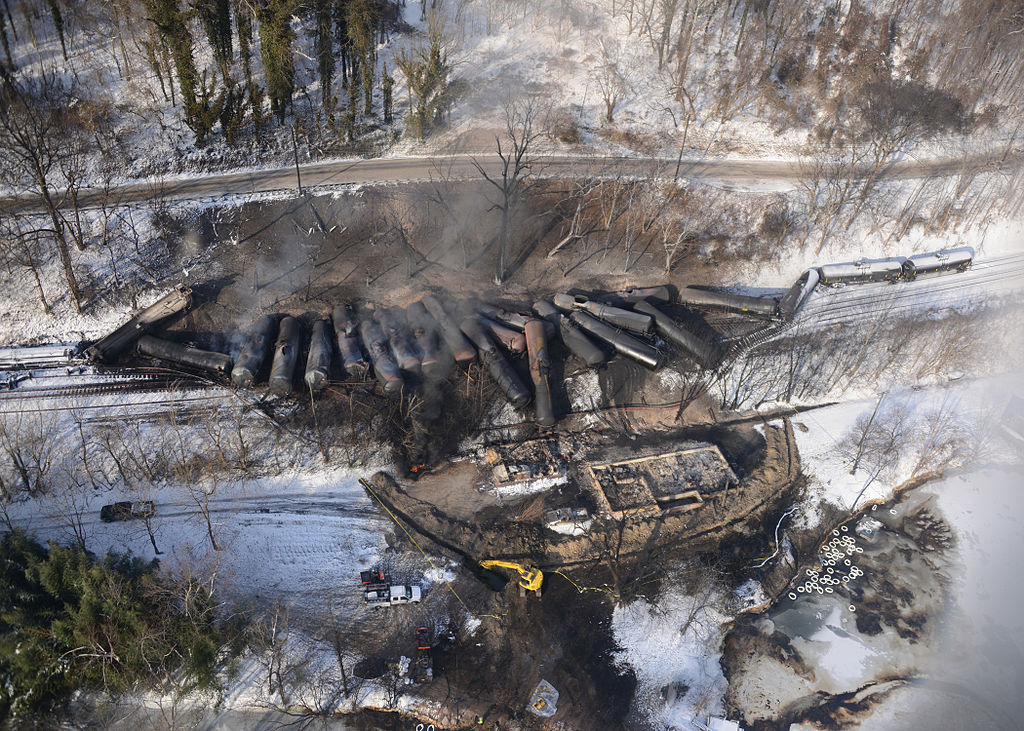When President Donald Trump signed executive orders pushing for the approval and expedited review of the Keystone XL and Dakota Access pipelines, an oil industry-funded think tank put out an interesting comment supporting the move in a press release:
“I believe that Canada is the largest supplier of foreign oil to the United States,” said Christopher Essex at the University of Western Ontario, on behalf of the climate change–denying Heartland Institute. “It gets there in part via huge dirty dangerously flammable trains of oil-bearing tank cars.”
But why was Heartland, which has received large amounts of funding from ExxonMobil, championing oil pipelines while highlighting the risks of oil trains?
A Change of Heart?
Exxon is owner of the largest oil-by-rail terminal in Canada. Is the oil industry — or at least its paid supporters — finally admitting that moving oil by rail might be too dangerous? Or is this just the latest talking point to push for more pipelines while fighting safety regulations for oil-by-rail?
“It’s remarkable to once again see the oil industry downplaying the risks of pipelines while emphasizing the all-too-real risks of oil trains,” Matt Krogh, director of the Extreme Oil campaign for advocacy group Stand, told DeSmog. “This is their MO: after every pipeline explosion, they demand more trains; after every oil train disaster, they demand more pipelines.”
Krogh believes the oil industry is now saying that moving oil by rail is dangerous as an argument to push for more pipelines.
Indeed, as the oil industry and its supporters have been celebrating Pres. Trump’s backing of pipeline projects, they have ended up telling the truth about the risks of oil trains in the process.
As reported by DeSmog Canada, Prime Minister Justin Trudeau has also recently used this argument to justify his support of pipelines, saying, “putting in a pipeline is a way of preventing oil by rail, which is more dangerous and more expensive.”
But Trudeau’s government is doing very little to make oil-by-rail safer even while admitting it is dangerous, as it continues to push through more tar sands pipelines.
And while the oil industry and Prime Minister Trudeau are pointing out the dangers of oil trains, at the 2016 Energy by Rail conference, the audience heard about how safe moving oil by rail was from Matt Rose, CEO of oil-by-rail leader Burlington Northern Sante Fe.
“It’s been an incredibly safe way to provide this country with a lot of choices,” Rose explained to the conference.
The reality is that oil trains carrying either Bakken oil or diluted bitumen (aka tar sands) can be quite dangerous, especially using current equipment and practices. But that hasn’t stopped the oil industry from using them or from working with the rail industry to fight any regulations that could make them safer.
Environmental Risks
While the Heartland Institute press release contains the truth about the risks of oil trains, it also claims that pipelines are better for the environment — something that isn’t supported by evidence.
Walter Starck, policy advisor on the environment for the Heartland Institute, made the case for pipelines and against moving oil-by-rail, saying, “Pipelines are simply safer, more economic, and present less environmental risk than does the currently used rail transport.”
While several of the oil train disasters have included very large oil spills, the modern record for the largest oil spill on land in North America is held by the 2010 tar sands pipeline spill into Michigan’s Kalamazoo River. Reuters recently reported the following information on the question of pipelines versus trains:
“Overall, oil spills [occur] more frequently with pipelines than rail cars, according to data from the Pipeline and Hazardous Materials Administration (PHMSA). For example, in 2015, there were 252 pipeline spills reported to PHMSA involving crude oil, versus 44 for the rail industry. The year prior, the frequency of spills at pipes was about 62 percent greater than rail, the data shows.”
However, in a world of “alternative facts,” the Heartland Institute has no problem asserting that pipelines are better for the environment.
Pipeline and Rail: An Industry Recipe for Profits
Michael Bourque is chief executive officer of the Railway Association of Canada. In December of 2015 he wrote an opinion piece in The Globe and Mail with the title “Trains complement pipelines, and are just as safe at transporting oil.”
So, while the current rush to build pipelines in the new Trump era is being bolstered by the argument that moving oil by pipeline is safer than moving the same oil by rail, the reality is that the oil industry will use whichever option is most profitable for a given project. As Bourque said, the two options complement each other in the eyes of the oil industry.
And at the same time the dangers of oil-by-rail are being touted by pipeline supporters, the oil industry is still proposing more potential oil-by-rail projects. The current oil and gas boom in Texas’ Permian Basin could lead to production outpacing pipeline capacity, and the industry is again poised to turn to rail just as it did in the Bakken region.
An example of how pipelines can actually increase oil by rail is the proposed Pilgrim pipeline that would connect Albany, New York, to the New Jersey coast. The oil to feed this pipeline would have to come to Albany via rail, however. That means building a pipeline would greatly increase the amount of oil being moved by rail from the Bakken region to the East Coast.
Of course, the argument being made for the Pilgrim pipeline project is that it will reduce the amount of oil barge traffic on the Hudson River.
Just this week an executive for oil company Tesoro was asking for political support for the proposed oil-by-rail facility in Vancouver, Washington, which would be the largest such facility in the country. Of course, he said, “It’s all about safety.”
And while the oil industry pushes for more pipelines to move tar sands oil from Alberta, the reality is that those pipelines are years away from completion, meaning oil-by-rail will continue ramping up in Canada over the next several years to cover that gap.
As we’ve already seen, the oil and rail industries will continue to fight new regulations for improving the safety of oil by rail while continuing to use rail to ship oil whenever it works best for business. The main reason oil-by-rail has fallen out of favor for now is that low oil prices, in most cases, make it no longer an economically viable option. It has nothing to do with safety or the environment.
So, in the future, whenever the economic case makes sense for the oil industry, expect more “dangerously flammable” oil trains to take to the rails.
Main image: An overhead view of the response to the 2015 Mount Carbon train derailment in Mount Carbon, West Virginia. The derailment caused the oil on board to ignite and resulted in an oil spill. Credit: U.S. Coast Guard, public domain
Subscribe to our newsletter
Stay up to date with DeSmog news and alerts






